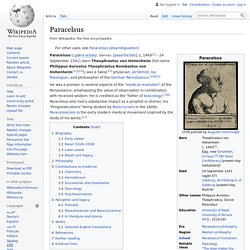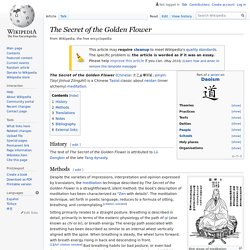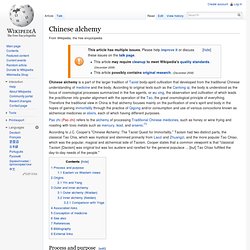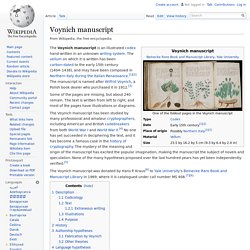

Paracelsus. Paracelsus (/ˌpærəˈsɛlsəs/; born Philippus Aureolus Theophrastus Bombastus von Hohenheim, 11 November or 17 December 1493 – 24 September 1541) was a Swiss German[3] Renaissance physician, botanist, alchemist, astrologer, and general occultist.[4] He founded the discipline of toxicology.[5] He is also known as a revolutionary for insisting upon using observations of nature, rather than looking to ancient texts, in open and radical defiance of medical practice of his day.[5] He is also credited for giving zinc its name, calling it zincum.[6][7] Modern psychology often also credits him for being the first to note that some diseases are rooted in psychological illness.[8] His personality was stubborn and independent.

He grew progressively more frustrated and bitter as he became more embattled as a reformer.[9] Paracelsus' most important legacy is likely his critique of the scholastic methods in medicine, science and theology. Biography[edit] Philosophy[edit] Contributions to medicine[edit] or. The Secret of the Golden Flower. The Secret of the Golden Flower (Chinese: 太乙金華宗旨; pinyin: Tàiyǐ Jīnhuá Zōngzhǐ) is a Chinese Taoist classic about neidan (inner alchemy) meditation.

History[edit] The text of The Secret of the Golden Flower is attributed to Lü Dongbin of the late Tang dynasty. Methods[edit] First stage of meditation Second stage of meditation Despite the varieties of impressions, interpretation and opinion expressed by translators, the meditation technique described by The Secret of the Golden Flower is a straightforward, silent method; the book's description of meditation has been characterized as "Zen with details".
Sitting primarily relates to a straight posture. The meditation technique is supplemented by descriptions of affirmations of progress in the course of a daily practice, suggesting stages that could be reached and phenomenon that may be observed such as a feeling of lightness, like floating upward or slight levitation. Amazon. How to Alchemise the New Moon Energy to Manifest your Goals. Every new moon that comes around I use as a checkpoint for my life. The new moon is about starting with an empty clean slate, it is the conception of an idea to become birthed into life with the coming full moon. I do this just like thousands of others have for literally hundreds of thousands of years to move, ebb and flow with the energy that is within all of the universe including us. For example farmers knew this, so they started to plan their harvests and seeding around the moon cycles. These farmers noticed through time passing that the seeds that took the best were seeded during the new moon.
The new moon is also a time of seeding ideas and intentions. This is a time I set my target for my deepest heartfelt desires and I am going to tell you how you can do this too. Moon Manifestation for Birthing Your Desires I always begin by setting aside some time most of the time it is by myself at night but you can also do this in a group. Supplies you May Need: So much light and love. The Secret of the Golden Flower. Translations[edit] "Gathering the light" -- an illustration of the first stage of meditation There are significant differences between the Wilhelm and Cleary translations. Wilhelm was introduced to the work by his Chinese teacher,[2] while Cleary arrived at his own translation and interpretation. Some translations are given with the word mystery for the word secret in the treatise's title. Classic works of Chinese philosophy preserve a spectrum of pre-modern science, from a time when philosophy and science were less distinct than they appear to be now.[3] The foundations of their teachings often appear incompatible with modern science, yet the teachings are of significant efficacy in providing a degree of awareness that might otherwise remain obscured by modern society’s attention to more stringent standards of rational thought (for a further discussion of possible benefits, see Meditation).
Meditation Technique[edit] Sitting primarily relates to a straight posture. Chinese alchemy. Chinese alchemy is a part of the larger tradition of Taoist body-spirit cultivation that developed from the traditional Chinese understanding of medicine and the body.

According to original texts such as the Cantong qi, the body is understood as the focus of cosmological processes summarized in the five agents, or wu xing, the observation and cultivation of which leads the practitioner into greater alignment with the operation of the Tao, the great cosmological principle of everything. Therefore the traditional view in China is that alchemy focuses mainly on the purification of one's spirit and body in the hopes of gaining immortality through the practice of Qigong and/or consumption and use of various concoctions known as alchemical medicines or elixirs, each of which having different purposes.
According to J.C. Voynich manuscript. The Voynich manuscript is an illustrated codex hand-written in an unknown writing system.

The vellum on which it is written has been carbon-dated to the early 15th century (1404–1438), and may have been composed in Northern Italy during the Italian Renaissance.[1][2] The manuscript is named after Wilfrid Voynich, a Polish book dealer who purchased it in 1912.[3] Some of the pages are missing, but about 240 remain. The text is written from left to right, and most of the pages have illustrations or diagrams. The Voynich manuscript has been studied by many professional and amateur cryptographers, including American and British codebreakers from both World War I and World War II.[4] No one has yet succeeded in deciphering the text, and it has become a famous case in the history of cryptography.